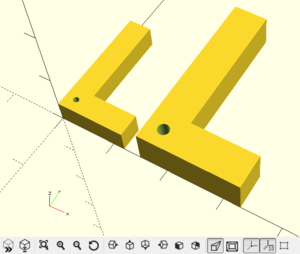OpenSCAD Seminar
Seminar on "Parametric modeling with OpenSCAD" by Mitja
We will give an introduction to parametric modeling and design a few things with OpenSCAD.
Basic Control
Have a look at OpenSCAD's user manual for more information and specific functions!
- type into the editor on the left
- whenever you are ready to compile your code to see it in the 3D preview on the right, you can click "preview" or hit F5
- group arguments with
{ ... }- group objects by applying
union()to a group of arguments - important for CNC!
- group objects by applying
- subtract objects or groups of objects from each other with
difference()- everything is subtracted from the first object or union after this function
!at the beginning of a line shows only that operation#at the beginning of a line shows that object as defined, e.g. also the superfluous parts of a hole
First Steps
We start by defining a small cube (units in mm) with cube([2,2,2]);.
- center the cube by adding
center=trueafter the vector, between ] and ) - translate (move) the cube by calling
translate([2,0,0])- it will end up two mm further in positive X direction
After also tinkering with some spheres and cylinders (enter $fn= followed by a number to define your desired face count, high numbers increase rendering time!), let's move on to parametric designs.
Parametric Designs
We'll make an "L" with adjustable side lengths and a parametric hole.
The "L" is rather simple and consists of two "cubes" that are actually rectangles due to the entered values. By adding the global variable "edge_length", we can later change the dimensions of the entire letter while keeping its proportions:
edge_length = 5;
union()
{
cube([1*edge_length,5*edge_length,1*edge_length]);
cube([3*edge_length,1*edge_length,1*edge_length]);
}
Then, we add a hole with a corresponding "hole_diameter" variable and turned the L into a module which can then be called similar to cube or sphere from the first examples:
module L(edge_length, hole_diameter)
{
difference()
{
union()
{
cube([1*edge_length,5*edge_length,1*edge_length]);
cube([3*edge_length,1*edge_length,1*edge_length]);
}
translate([edge_length/2, edge_length/2, -1])
cylinder(r=hole_diameter/2, h=edge_length+2, $fn=20); //sticks out 1 mm at top/bottom, "centered" in corner
}
}
L(4,1);
translate([15,0,0]) L(6,2);

The last two lines in this example create two "L" shapes with different sizes, one of which starts at the origin while the other is moved 15 mm in X direction.
Uploading to Thingiverse (Customizer)
Uploading the design to Thingiverse is easy, just click "This is a customizer" in the process and the app will automaticall parse your variable names and the associated comments. Make sure to comment precisely and understandably so others enjoy your customizable creation!